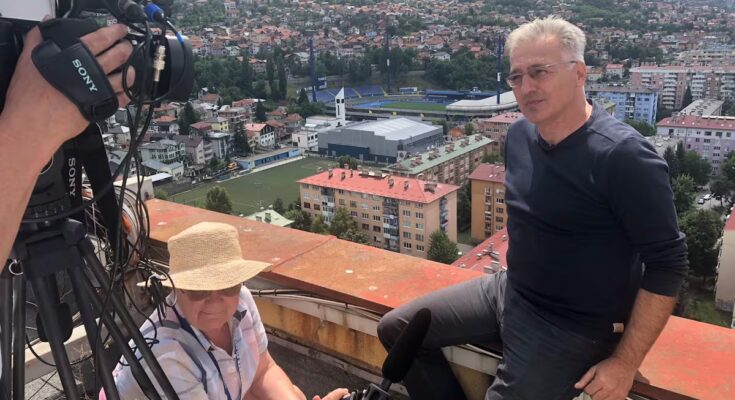The Bosnian pensioner Edin Subasic, 62 years old, is today one of the most requested people by the international press. Their testimony may be the key to determining whether the so-called human safaris, presumably perpetrated in the 1990s during the siege of Sarajevo, at the height of the Balkan wars. That is, if Italian civilians went to the front on weekends to kill “for a price” the people who suffered the longest military siege of a capital city in modern history (1992-1996). His words are of vital importance in the investigation launched this week by the Milan Prosecutor’s Office.
Both Subasic and Benjamina Karic, first mayor of the Novo Sarajevo neighborhood and mayor of the Bosnian capital between 2021 and 2024, explain via email and WhatsApp what they know on the issue. Both are confident that justice will be done, even though neither of them has yet been cited by the judicial authorities of Bosnia-Herzegovina, the Italian ones or the Criminal Court in The Hague for war crimes committed in the Balkans.
Subasic was a literature professor who worked as a journalist in his country. At the start of the war, in 1992, he joined the Army of the Republic of Bosnia and Herzegovina (ARBiH) and soon joined the Military Intelligence Service. He was working there when he heard about “human safaris.” “The most shocking thing to me was that the snipers of the safari They chose whether to kill an adult civilian, a woman, a child, a pregnant woman, a soldier… And everything had its price! Macabre and sick.”
In late 1993, General Mustafa Hajrulahovic, head of military intelligence (died 1999), tasked Subasic with analyzing data obtained from interrogations of Serbian prisoners. There he found the testimony of a Serbian volunteer: “He was a young man of about 20 years old, originally from the city of Paracin, Serbia. He got lost in the urban area of the front, looted abandoned houses and entered the area controlled by the ARBiH, where he was captured.”
When questioned about how he arrived at the front, the number of Serbian volunteers or the type of weapons, the prisoner stated that he had arrived by bus with a group of Serbs and another group of foreigners, “five Italians who had hunting equipment and expensive weapons”. “He spoke to one of them, who was from Milan. He told him that they were not mercenaries who received money, but hunters who paid Serbs in Sarajevo to shoot people in the city,” Subasic points out. “It was a surprise for him too, which is why he told me about it straight away! It was the first time I’d heard something like that.”
The prisoner was interrogated twice, according to Subasic. “We learned that the Italians got off the bus in Pale (a town 15 kilometers from Sarajevo), where special military forces with jeepSubasic prepared an analysis and presented it to his superiors; then the head of the Service contacted the officers of SISMI (the former Italian secret service agency) stationed in the UN peacekeeping force (Unprofor) and informed them of what had happened. “We asked them to verify and intervene in Italy.”
Subasic adds that, at the beginning of 1994 – between March and April – during an information meeting, the head of the Service informed him that SISMI had confirmed the prisoner’s information. The Italian agency informed them that the place from which the groups departed had been located and that said activity had been neutralized and would not be repeated. “SISMI’s response was a confirmation that the prisoner’s information was correct. The Service then closed the case, we considered it resolved and we concentrated on other problems, given that that was the most difficult year of the war.”
The former secret service agent says that, in the words of the Serbian prisoner, the “hunter-snipers” used combined transport… “They traveled by plane from Italy to Hungary and then by land to Belgrade. From Belgrade to Sarajevo they went by bus or helicopter to Pale and from there to Sarajevo. Their guides on the conflict lines were the special forces of the Serbian army.”
Although there was a formal ban on civilian flights, he explains, snipers often took advantage of humanitarian flights to Serbia. “Furthermore, the helicopter transport to Bosnia (Pale) was carried out by Serbian military helicopters, violating the flight ban. That ban was violated throughout the war. All sides did so. I myself flew with ARBiH helicopters during the war. We risked being subjected to NATO air attacks.”
The former soldier claims that the safari it could only be organized with a “highly professional structure” and that “the core of that group was formed by members of the Serbian Security Service”. The operational mode – from transport to front-line infiltration – required such a level of coordination and confidentiality that, according to him, there could only be a “powerful” service with authority in Serbia and among the Bosnian Serbs behind the operation.
Subasic recounted his experience in the documentary Safari in Sarajevobroadcast in 2022 by Al Jazeera Balkans, a channel that was closed last July. He was also contacted by the Italian journalist and writer Ezio Gavazzeni, who has been investigating the matter for years and presented a 17-page complaint to the Milan Prosecutor’s Office. “I know that some names of snipers have emerged from Gavazzeni’s investigation. Now it is better to keep any new information secret so as not to hinder” the investigations.
Benjamina Karic, who as a child experienced the siege in the Grbavica neighborhood, the most affected by snipers, felt “a profound moral, human and official obligation to act” after watching the documentary. He had studied law and was at the time mayor of the capital of this country of 3.4 million people. “I have filed a criminal complaint with the Prosecutor’s Office of Bosnia and Herzegovina against the unknown perpetrators who killed my fellow citizens, with the Special Department for War Crimes.”
Subsequently Karic expanded his complaint with the testimony of the American John Jordan, of Unprofor, who during the war in Sarajevo served in the fire brigade and “witnessed the arrival of the hunters”. “His testimony has already been accepted as evidence in the trials of Serbian generals Svetozar Galić and Dragomir Milosevic before the Hague Tribunal. I have attached this evidence to the complaint submitted to the Prosecutor’s Office, since it can be used in two separate proceedings.”
The first mayor of Novo Sarajevo says that the case continues to be handled at the Prosecutor’s Office. And that several of your urgent requests have not produced any results to speed up the procedure. For his part, Subasic claims that, despite being a potential witness, he was never called to testify by his country’s prosecutor’s office following Karic’s complaint. “I am waiting for the summons. I have made everything I know available to the Milan Prosecutor’s Office, through Ezio Gavazzeni. I am also waiting for the invitation to testify in the Milan investigations. I want to believe that justice, even if slow, will finally come to the murderers and the organisers”.
Public pressure
The former member of the Bosnian secret services concludes: “I hope that the pressure of public opinion in Bosnia will push the Prosecutor’s Office to work actively on this case. There are documents about it in the SISMI archives and in the Bosnian military archives. There is the aforementioned report of the prisoner’s interrogation and my analysis. After 30 years I don’t remember the name of that soldier, but it’s all in the archives and the Prosecutor’s Office can obtain it.”
Karic is also optimistic: “I firmly believe that justice will finally be done. If I hadn’t had this belief I wouldn’t have undertaken this fight.”
Dzemil Hodzic, a Sarajevo-based Al Jazeera video editor, saw his 16-year-old brother shot to death by a sniper when he was nine. Today, at 42, he is working on a series of interviews entitled Sniper Alley Photo, available on YouTube, in which he interviews photographers who covered the war. In the video dedicated to the Italian photojournalist Mario Boccia, he says (minute 8:56): “This place brings to mind particular memories. Memories of foreigners who came here to see the fighting. In a base (near) Grbavica I found a boy who came from Greece, a young boy who came to fight in the name of Orthodox solidarity. Another boy came from New York. He was of Serbian origin. I also have photos of Russians who fought in Trebinje alongside the Serbs”.
None of them, however, paid to kill. Boccia had no evidence of that type of tourism. But Hodzic doesn’t doubt that they existed. “For us survivors, weekends were the worst. They seemed to come and go crazy and overdo it. If they paid to do it, it would all make more sense.”



